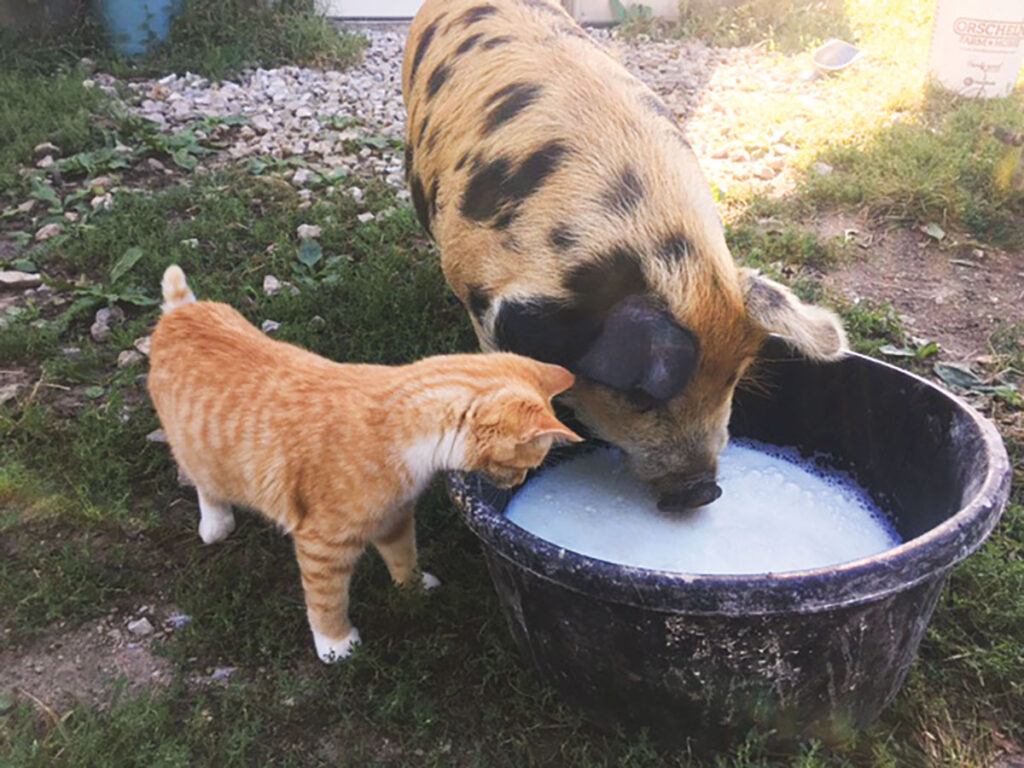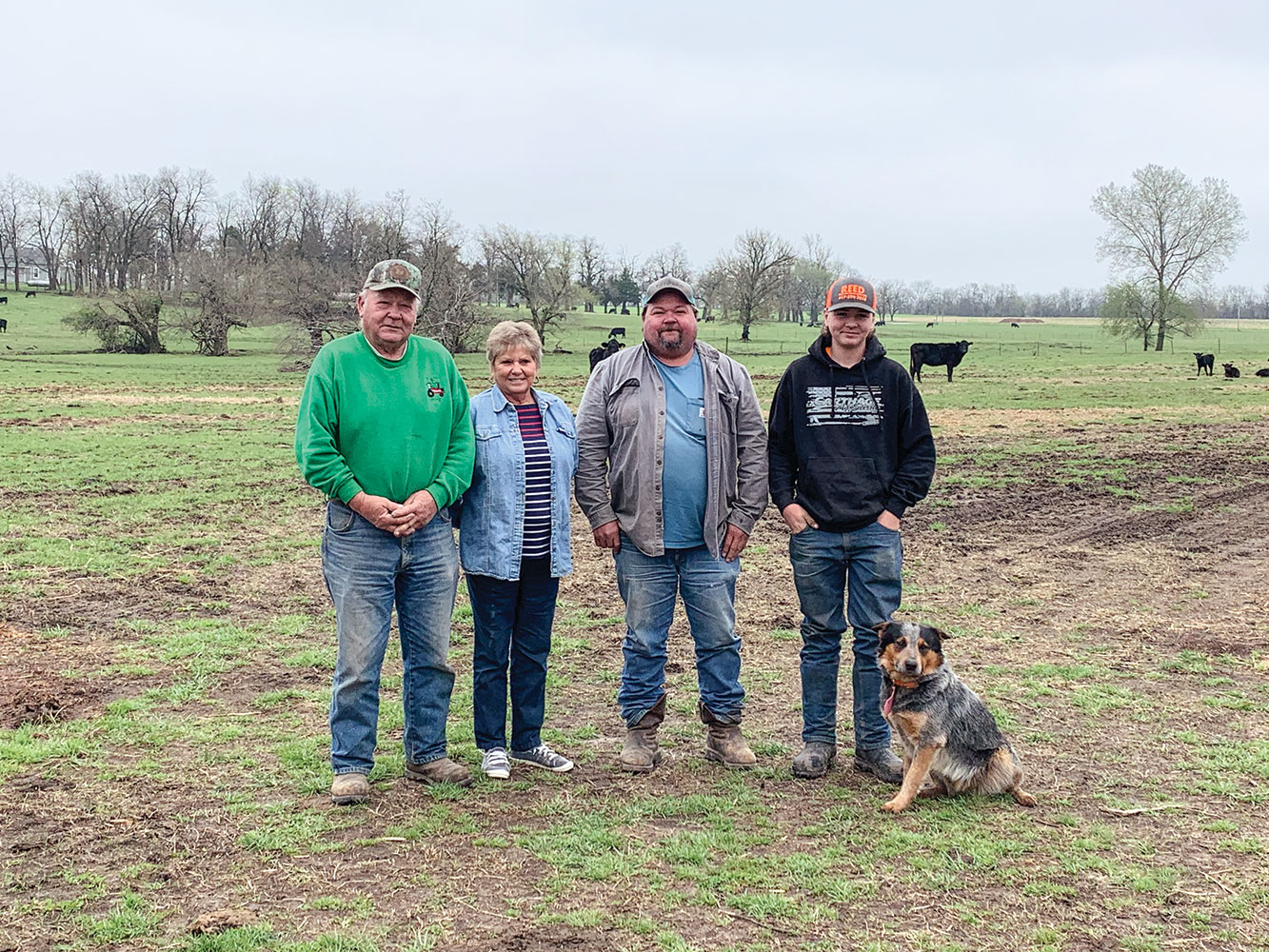
Piney Creek Farm is improving its ecosystem
CABOOL, MO. – Farming is sometimes a battle against Mother Nature, but Adam Stevens says it doesn’t have to be.
Adam and his family own and operate Piney Creek Farm, a 42-acre farm near Cabool, Mo., where they have a few dairy cows, pigs, sheep and chickens and grow vegetables.
The family moved to the Ozarks from a homestead in Oregon in 2019 with a plan to expand.
“My mom had already moved to Missouri, so we thought it was a good opportunity to chase the dream,” Adam, who grew up in the suburbs of Salt Lake City, Utah, explained. “We were scaling up our small farm; we had done some pastured meat sales and some vegetables, so we had gotten our feet wet.”
Adam has been a student of the permaculture farming method for many years. Before moving to the Ozarks, he became a certified permaculture designer, incorporating and sometimes modifying the teachings of Joel Salatin and Greg Judy among others.
“Through the course of studies, it became very clear that there is an intelligent design in nature,” Adam explained. “I believe that design was created by God and that God works in different patterns. If we look at nature, we can observe those patterns, which will inform us of the natural laws. If we obey natural laws and mimic natural patterns, we are more in line with how things are supposed to work. That allows us to be much more efficient and, hopefully, have an easier time doing things. Nature is a force to be reckoned with, and it’s easier to work with something than against it.”
Permaculture isn’t a farming method, he added. It’s the way one views the world and solves problems.
“It’s a design language,” Adam said. “When you use the appropriate language, the natural answers come out. If you can properly describe a situation, you can find the right answer to your questions. We pull from a wide variety of disciplines to solve our problems, looking at it through the view of permaculture. There is no permaculture garden; it’s not plant this next to this. There are all the ways people can garden or farm; some are going to fit within a permaculture view, some are not.”
An example Adam offered was that wild blueberries occur in nature, but there will not be large, natural blueberry fields.
“You can have a 100-acre farm and have 30 acres of berries that you can mechanically harvest, which is perfectly fine, but the way you lay it out and interact with the system would be different,” he said. “I wouldn’t put in 30 acres of just blueberries because nature doesn’t work that way. You will never find a mono-crop in nature; it doesn’t exist. We look at a robust ecosystem, and there are layers there. For example, blueberries are shrubs, and that’s only one of the six layers, so what else can you grow in that space? If you stumble upon a wild blueberry location, you have the blueberries, but you would also have trees, the ground cover, different things that flower, and so forth. It’s not just the things we plant; it’s that cohesive system we are working to design and build . The patterns are the same, but the systems and scale are different when someone designs a homestead, as opposed to someone trying to build a 100-acre farm.”
Permaculture is also about the interaction of systems in a beneficial way.
“As we look at the different elements of our farm, it’s not just one thing; what else can I do with it, and how can I connect the output of one thing to the inputs of another,” Adam said.
Manure from the milking parlor area is collected and moved to a compost pile. Once the compost pile is fully operational, it will be managed by the chickens.

“Any spent grain from the dairy cows in the manure, the laying chickens work the compost system, pick it out and spread the manure. We will mix in other waste, like spent hay, scraps from the garden and other compostable things, and the chickens will get a good part of their food from the compost system. They will scratch and turn the compost, add their own fertility to it, and that compost will then go into the garden.
“I have taken three typically unrelated things and connected them all so the outputs of one and the inputs of the other. On a homestead scale, if we completed that loop, I can then grow food to feed my cows at milking time instead of buying grain.”
The managed grazing program is one operational “loop” on Piney Creek Farm. The dairy cows move through a paddock first, followed by the flock of haired sheep, then the Kunekune/American Guinea Hog herd, and finally, the chickens.
“They all eat differently and have different components in their manure,” Adam said. “Your cows and sheep compete a little, but there are things the sheep will eat that the cows don’t and vice versa. The cows go first and get the cream of the crop; the sheep are the next level after that. The pigs eat differently than the cow or the sheep, and the pigs will spread out the manure looking for the spent grain. The chickens are the clean-up crew and will spread the manure because they are looking for the fly larva.”
The pigs and chickens, Adam added, also disturb the seed bank and can quickly build soil if managed correctly.
There is no set pattern in the rotation of paddocks, and movement has several variables.
“For the pigs, we have breeding stock to manage, so they aren’t always going to move right away,” Adam said. “There are some paddocks, because of drought, you don’t want to run everyone through because it is going to destroy the grass. There’s also going to be paddocks with problem areas that you want the pigs to fix for you because they will root out blackberries, shrubs, trees and such and help convert it to grassland.”
Timing, Adam added, is also a contributing factor to the rotational pattern.
“That’s where you, again, get into recognition of patterns within nature,” he said. “We can say, ‘this is what’s going to happen when this animal is in there, and this is the aftermath.’ Last year, when we got into a drought, I didn’t want the pigs out tearing up my best pasture, so I will leave the pigs longer in the marginal land. It will be a higher-impact, longer duration, and when they leave, you will have a longer rest period and allow that land to recover.”
Adam said the forages on the farm were primarily there when they arrived, but introducing a management system has allowed those plants to grow, and new ones have arrived.
“We have oversewn some clover, Orchardgrass and things. I will stop on the side of the road if I see a healthy stand of early rye, and I will pick that and throw it out, or if I get some little bluestem seed, but mostly we work with what we have,” Adam said. “Part of that is economics, but there is so much diversity in nature that you’re going to grow to your management. How you manage it will determine the forages you have. Some seeds can stay viable for hundreds of years in the seed bank. One thing I picked up from Joel Salatin was to graze what you have and let nature provide. If you find the stuff growing in the ditches, add that as it doesn’t need help.
“There is no scarcity in God’s system. Everything we need to exist can be provided if we would just let it and get out of the way.”
An example Adam offered was the growth of Timothy and clover in a farrowing area last year.

“The combination of drought and keeping the pigs in one paddock longer than I typically would led them to obliterating it. I was like, “Man, what are we going to get to come back?’ I was thinking ragweed and all kinds of stuff I don’t want. But that’s not what we got. We got Timothy and clover. It’s because Timothy and clover were already in the soil, the pigs hit it hard, then it got a long rest. There was plenty of manure and urine, and the land saw an increase in fertility, so rather than bring the ragweed and annual weeds back that are repairing mechanism, it grew grass and cover because it was already repaired.”
The smaller animal breeds were selected based on their breeds’ performance in a pastured situation.
The Kune Kune/American Guinea Hogs were selected because they are smaller, are easier on the land, and are known to forage. The pigs are also not aggressive rooters. The Cornish-cross broilers are a common pasture-raised meat bird, and the Dorper/Katahdin cross sheep offer disease resistance and hardiness.
The Stevens family offers raw milk from their dairy-cross cows, lamb, pork and chicken. Chickens are processed on the farm. Because they want the lives of animals to be as stress-free as possible, the on-farm harvest is important to Adam. The family will harvest and process animals for their use, but the animal meant for customers are done by a third party and then taken to area custom processors.
The farm does not offer beef but hopes to add that product in the future.
Grain fed to livestock is an organic mix from Peterson Organics in Mountain Grove, Mo.
“I don’t think Missouri, at least our place, has sufficient nutrients during certain times of the year to meet all of the animal’s nutritional requirements,” Adam said. “We minimize the grain we give, and our current ration is 75 percent alfalfa pellets, with wheat and corn because they need the carbohydrates, other fats, and energy that isn’t always available to them. I would rather have healthy animals than stick to only grass-fed and let their health suffer. A dairy animal’s requirements are so much higher. Our sheep only get grain as a training aid to get them to come to me when I call them.”
Piney Creek Farm has downsized some of its livestock operations to refine genetics or feed costs, but they are far from slowing down.
“This is a multi-year process when you are designing and implementing holistic symptoms; there are a lot of pieces,” Adam said. “The full implementation schedule for what we want to do is between five and seven years, at a minimum. We understand what needs to happen, but you can only do so much in a day, week or year. With what we are doing, we implement as much as we can, understanding not everything is connected the way it should be.”







